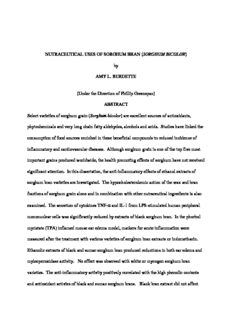
NUTRACEUTICAL USES OF SORGHUM BRAN (SORGHUM BICOLOR) by AMY L. BURDETTE ... PDF
Preview NUTRACEUTICAL USES OF SORGHUM BRAN (SORGHUM BICOLOR) by AMY L. BURDETTE ...
NUTRACEUTICAL USES OF SORGHUM BRAN (SORGHUM BICOLOR) by AMY L. BURDETTE (Under the Direction of Phillip Greenspan) ABSTRACT Select varieties of sorghum grain (Sorghum bicolor) are excellent sources of antioxidants, phytochemicals and very long chain fatty aldehydes, alcohols and acids. Studies have linked the consumption of food sources enriched in these beneficial compounds to reduced incidence of inflammatory and cardiovascular diseases. Although sorghum grain is one of the top five most important grains produced worldwide, the health promoting effects of sorghum have not received significant attention. In this dissertation, the anti-inflammatory effects of ethanol extracts of sorghum bran varieties are investigated. The hypocholesterolemic action of the wax and bran fractions of sorghum grain alone and in combination with other nutraceutical ingredients is also examined. The secretion of cytokines TNF-α and IL-1 from LPS-stimulated human peripheral mononuclear cells was significantly reduced by extracts of black sorghum bran. In the phorbol myristate (TPA) inflamed mouse ear edema model, markers for acute inflammation were measured after the treatment with various varieties of sorghum bran extracts or indomethacin. Ethanolic extracts of black and sumac sorghum bran produced reductions in both ear edema and myleoperoxidase activity. No effect was observed with white or mycogen sorghum bran varieties. The anti-inflammatory activity positively correlated with the high phenolic contents and antioxidant activies of black and sumac sorghum brans. Black bran extract did not affect COX-2 protein expression, an enzyme involved in prostaglandin biosynthesis. Black sorghum bran extract in combination with indomethacin did not produce a greater effect than each agent alone suggesting that this bran may also block an enzyme involved in prostanoid production. Additional studies undertaken demonstrated that integration of sorghum wax into hypercholesterolemic diets did not produce any lipid-altering effects. A diet composed of 20% sorghum bran significantly lowered plasma cholesterol. A formulation comprised of a blend of phytosterols, Spirulina, turmeric and pantethine, produced lipid-lowering effects in the hypercholesterolemic hamster. The addition of 5% or 10% sorghum bran to this formulation produced a further modest lowering of plasma cholesterol levels. In conclusion, select sorghum bran varieties may be a beneficial food/nutraceutical ingredient for the moderation of inflammatory diseases and maintaining healthy plasma cholesterol concentrations. INDEX WORDS: Sorghum bran, cholesterol, anti-inflammatory, nutraceutical and phytochemicals NUTRACEUTICAL USES OF SORGHUM BRAN (SORGHUM BICOLOR) by AMY L. BURDETTE B.S., Georgia College & State University, 2003 A Dissertation Submitted to the Graduate Faculty of The University of Georgia in Partial Fulfillment of the Requirements for the Degree DOCTOR OF PHILOSOPHPY ATHENS, GEORGIA 2007 © 2007 Amy L. Burdette All Rights Reserved NUTRACEUTICAL USES OF SORGHUM BRAN (SORGHUM BICOLOR) by AMY L. BURDETTE Major Professor: Phillip Greenspan Committee: Diane K. Hartle James L. Hargrove Opal Bunce Roger Dean Electronic Version Approved: Maureen Grasso Dean of the Graduate School The University of Georgia December 2007 DEDICATION To my grandparents that I have lost along this journey… Your love and friendship has had a large impact in the person I am today. iv ACKNOWLEDGMENTS I would like to thank first my major advisor, Dr. Phillip Greenspan. It has been a very rewarding experience working under your direction. Not only have you helped me become a better scientist but you demonstrated the best remedy for many of life’s problems is laughter. You truly are a gifted teacher. I would also like to thank my committee members Dr. Hartle, Dr. Hargrove, Dr. Bunce and Dr. Dean. I owe special thanks to Dr. Hartle and Dr. Hargrove for their support. I am forever appreciative of my professors at Georgia College & State University for encouraging me to continue my education. To my labmates, Linda Duncan and Eve Bralley, I have always believed that people come into our lives to fulfill a certain purpose and meaning. Your presence in my life only solidifies this belief. I cannot convey how much your friendship has meant to me. Although I will miss our talks over lunch, animal care procedures and lab time; I will forever be grateful for the lasting relationships we have built. I am grateful to the American Foundation for Pharmaceutical Education for their generous monetary support. I would also like to thank Mary Eubanks and Joy Wilson for their assistance throughout my graduate program. To my sister Dena, the person who has always known me best, I cannot thank you enough for your love and friendship. I am a stronger person knowing you are always there for v me. Thank you for the many phone calls and your calming voice. Thank you for being my angel. To my parents, Dave and Diane, thank you for believing in me, encouraging me and unconditional love. Most importantly, thank you for inspiring me to dream and supporting my decisions. You both model the type of the person I aspire to be. Finally, I would like to thank my husband, Cory, for your patience, understanding and sacrifices you’ve made only to support my career. Your love and support has helped make this possible. Achieving my goals would not be as rewarding without you in my life. Most of all, thank you for bringing to my life laughter, compassion, friendship and for putting everything into perspective. As we end one milestone in our lives, I am excited to see what our future holds. v i TABLE OF CONTENTS Page ACKNOWLEDGMENTS...............................................................................................................v CHAPTER 1 INTRODUCTION AND LITERATURE REVIEW.....................................................1 Sorghum Grain..........................................................................................................4 Phytochemicals..........................................................................................................7 Inflammation...........................................................................................................15 Cardiovascular Disease...........................................................................................24 Hypothesis Tested...................................................................................................34 References...............................................................................................................36 2 ANTI-INFLAMMATORY EFFECTS OF SELECT VARIETIES OF SORGHUM BRAN EXTRACTS................................................................................................57 Abstract...................................................................................................................58 Introduction.............................................................................................................59 Methods...................................................................................................................60 Results.....................................................................................................................66 Discussion...............................................................................................................70 Acknowledgments...................................................................................................76 References...............................................................................................................77 vi i 3 EFFECT OF SORGHUM BRAN AND WAX FRACTIONS ON PLASMA CHOLESTEROL CONCENTRATIONS IN HAMSTERS..................................101 Abstract.................................................................................................................102 Introduction...........................................................................................................103 Methods.................................................................................................................104 Results...................................................................................................................106 Discussion.............................................................................................................107 Acknowledgments.................................................................................................111 References.............................................................................................................112 4 A NUTRACETICAL FORMULATION LOWERS PLASMA LIPIDS IN THE HYPERLIPIDEMIC HAMSTER..........................................................................122 Abstract.................................................................................................................123 Introduction...........................................................................................................124 Methods.................................................................................................................125 Results...................................................................................................................128 Discussion.............................................................................................................130 Acknowledgments.................................................................................................134 References.............................................................................................................135 5 CONCLUSIONS........................................................................................................147 vi ii
Description: